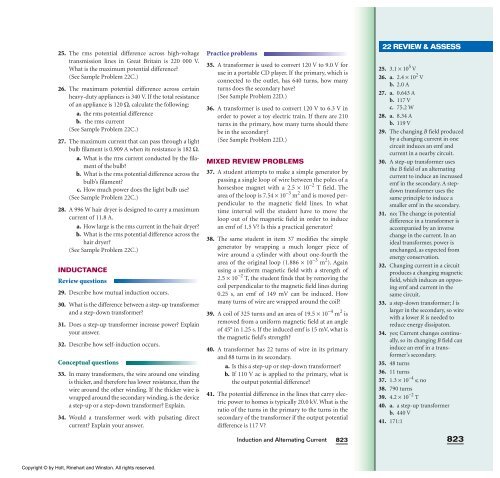Induction and Alternating Current with teacher's notes
Induction and Alternating Current with teacher's notes
Induction and Alternating Current with teacher's notes
Create successful ePaper yourself
Turn your PDF publications into a flip-book with our unique Google optimized e-Paper software.
25. The rms potential difference across high-voltage<br />
transmission lines in Great Britain is 220 000 V.<br />
What is the maximum potential difference?<br />
(See Sample Problem 22C.)<br />
26. The maximum potential difference across certain<br />
heavy-duty appliances is 340 V. If the total resistance<br />
of an appliance is 120 Ω, calculate the following:<br />
a. the rms potential difference<br />
b. the rms current<br />
(See Sample Problem 22C.)<br />
27. The maximum current that can pass through a light<br />
bulb filament is 0.909 A when its resistance is 182 Ω.<br />
a. What is the rms current conducted by the filament<br />
of the bulb?<br />
b. What is the rms potential difference across the<br />
bulb’s filament?<br />
c. How much power does the light bulb use?<br />
(See Sample Problem 22C.)<br />
28. A 996 W hair dryer is designed to carry a maximum<br />
current of 11.8 A.<br />
a. How large is the rms current in the hair dryer?<br />
b. What is the rms potential difference across the<br />
hair dryer?<br />
(See Sample Problem 22C.)<br />
INDUCTANCE<br />
Review questions<br />
29. Describe how mutual induction occurs.<br />
30. What is the difference between a step-up transformer<br />
<strong>and</strong> a step-down transformer?<br />
31. Does a step-up transformer increase power? Explain<br />
your answer.<br />
32. Describe how self-induction occurs.<br />
Conceptual questions<br />
33. In many transformers, the wire around one winding<br />
is thicker, <strong>and</strong> therefore has lower resistance, than the<br />
wire around the other winding. If the thicker wire is<br />
wrapped around the secondary winding, is the device<br />
a step-up or a step-down transformer? Explain.<br />
34. Would a transformer work <strong>with</strong> pulsating direct<br />
current? Explain your answer.<br />
Copyright © by Holt, Rinehart <strong>and</strong> Winston. All rights reserved.<br />
Practice problems<br />
35. A transformer is used to convert 120 V to 9.0 V for<br />
use in a portable CD player. If the primary, which is<br />
connected to the outlet, has 640 turns, how many<br />
turns does the secondary have?<br />
(See Sample Problem 22D.)<br />
36. A transformer is used to convert 120 V to 6.3 V in<br />
order to power a toy electric train. If there are 210<br />
turns in the primary, how many turns should there<br />
be in the secondary?<br />
(See Sample Problem 22D.)<br />
MIXED REVIEW PROBLEMS<br />
37. A student attempts to make a simple generator by<br />
passing a single loop of wire between the poles of a<br />
horseshoe magnet <strong>with</strong> a 2.5 × 10 −2 T field. The<br />
area of the loop is 7.54 × 10 −3 m 2 <strong>and</strong> is moved perpendicular<br />
to the magnetic field lines. In what<br />
time interval will the student have to move the<br />
loop out of the magnetic field in order to induce<br />
an emf of 1.5 V? Is this a practical generator?<br />
38. The same student in item 37 modifies the simple<br />
generator by wrapping a much longer piece of<br />
wire around a cylinder <strong>with</strong> about one-fourth the<br />
area of the original loop (1.886 × 10 −3 m 2 ). Again<br />
using a uniform magnetic field <strong>with</strong> a strength of<br />
2.5 × 10 −2 T, the student finds that by removing the<br />
coil perpendicular to the magnetic field lines during<br />
0.25 s, an emf of 149 mV can be induced. How<br />
many turns of wire are wrapped around the coil?<br />
39. A coil of 325 turns <strong>and</strong> an area of 19.5 × 10 −4 m 2 is<br />
removed from a uniform magnetic field at an angle<br />
of 45° in 1.25 s. If the induced emf is 15 mV, what is<br />
the magnetic field’s strength?<br />
40. A transformer has 22 turns of wire in its primary<br />
<strong>and</strong> 88 turns in its secondary.<br />
a. Is this a step-up or step-down transformer?<br />
b. If 110 V ac is applied to the primary, what is<br />
the output potential difference?<br />
41. The potential difference in the lines that carry electric<br />
power to homes is typically 20.0 kV. What is the<br />
ratio of the turns in the primary to the turns in the<br />
secondary of the transformer if the output potential<br />
difference is 117 V?<br />
<strong>Induction</strong> <strong>and</strong> <strong>Alternating</strong> <strong>Current</strong><br />
823<br />
22 REVIEW & ASSESS<br />
25. 3.1 × 10 5 V<br />
26. a. 2.4 × 10 2 V<br />
b. 2.0 A<br />
27. a. 0.643 A<br />
b. 117 V<br />
c. 75.2 W<br />
28. a. 8.34 A<br />
b. 119 V<br />
29. The changing B field produced<br />
by a changing current in one<br />
circuit induces an emf <strong>and</strong><br />
current in a nearby circuit.<br />
30. A step-up transformer uses<br />
the B field of an alternating<br />
current to induce an increased<br />
emf in the secondary. A stepdown<br />
transformer uses the<br />
same principle to induce a<br />
smaller emf in the secondary.<br />
31. no; The change in potential<br />
difference in a transformer is<br />
accompanied by an inverse<br />
change in the current. In an<br />
ideal transformer, power is<br />
unchanged, as expected from<br />
energy conservation.<br />
32. Changing current in a circuit<br />
produces a changing magnetic<br />
field, which induces an opposing<br />
emf <strong>and</strong> current in the<br />
same circuit.<br />
33. a step-down transformer; I is<br />
larger in the secondary, so wire<br />
<strong>with</strong> a lower R is needed to<br />
reduce energy dissipaton.<br />
34. yes; <strong>Current</strong> changes continually,<br />
so its changing B field can<br />
induce an emf in a transformer’s<br />
secondary.<br />
35. 48 turns<br />
36. 11 turns<br />
37. 1.3 × 10 −4 s; no<br />
38. 790 turns<br />
39. 4.2 × 10 −2 T<br />
40. a. a step-up transformer<br />
b. 440 V<br />
41. 171:1<br />
823
















